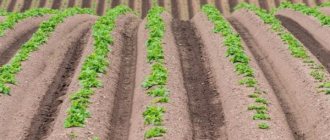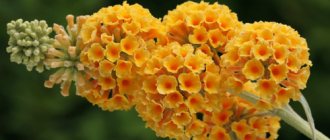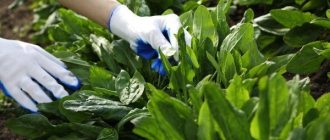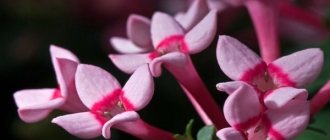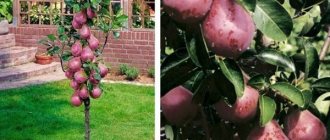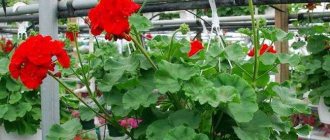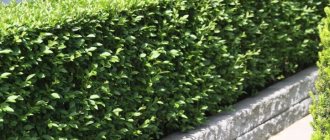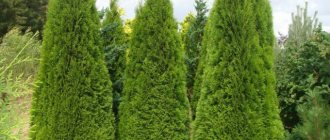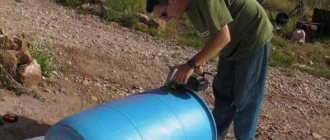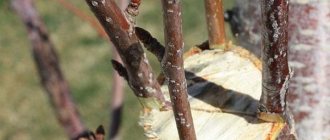Author: Natalya Category: Garden plants Published: February 09, 2019Republished: February 09, 2019Last edits: January 13, 2021
- When to plant
- Growing conditions
- How and when to collect seeds
- Buddleja davidii
shrub (lat. Buddleja) , or buddleya , is a genus of flowering plants of the Norichaceae family, representatives of which grow in warm and temperate regions of South Africa, Asia and America. The buddleia plant received its name in honor of Adam Buddle, an English botanist of the late 17th and early 18th centuries, in whose homeland the buddleia bush was called orange-eyed. “Butterfly magnet” or “moth tree” – these are the nicknames the buddleia received because it is pollinated by large, beautiful butterflies, attracted by the honey aroma of the plant’s flowers. The flowering of buddleia resembles clusters of lilacs, for which it is sometimes called autumn lilac.
Planting and caring for Buddleia
- Planting: sowing seeds for seedlings - in early spring, planting seedlings in the ground - in mid-May.
- Flowering: at the end of summer for 1-1.5 months.
- Lighting: bright sunlight.
- Soil: moist, nutritious, fertile, well-drained, neutral reaction.
- Watering: only in extreme heat, consumption - 1 bucket of water per 1 bush.
- Fertilizing: 2-3 times per season with potassium-phosphorus fertilizers alternately with organic humus or liquid compost.
- Pruning: in early spring, low-growing species are pruned at a height of 30 cm from the surface, and tall ones - at a level of 90 cm.
- Reproduction: seeds and cuttings.
- Pests: spider mites and whiteflies.
- Diseases: gray rot.
Read more about growing buddleia below.
Seven secrets of success:
| 1. Growing temperature : summer - 18 - 24 ° C, in winter there is a cool dormant period at a temperature of 10 - 13 ° C. |
| 2. Lighting : A well-lit location with plenty of reflected sunlight is best. |
| 3. Watering and air humidity : water with warm water during spring and summer in such a way as to dry out a 2-3 cm thick layer of soil between them. In autumn, watering is reduced and in winter it protects the soil from completely drying out. Increase the humidity when the summer heat sets in or when the heating is on during the winter months. |
| 4. Trimming : formative cutting and sanitary regular pruning with a sharp sterile instrument. Mature plants can also be rejuvenated with a dramatic pruning. |
| 5. Soil : Tolerates a wide range of soil conditions as long as there is good drainage. |
| 6. Feeding : every 2 weeks with liquid mineral or organic fertilizers in half concentration during the warm season. In the fall, fertilizing is reduced and in winter the plants are put into a dormant period, denying the flower the application of fertilizers. |
| 7. Reproduction : by sowing seeds in autumn or spring, after cool stratification, by cuttings in the warm season, by root shoots. |
Botanical name: Buddleja, Nicodemia.
Buddleia flower - family . Buddleiaceae.
Where does it grow ? Madagascar.
Description. Ornamental buddleia or nicodenia is a very showy evergreen plant for large sunny rooms or greenhouses. Strongly growing, erect specimens of this shrub can reach a height of 1.8 - 3 m or more.
Lanceolate dark green leaves 13 cm long. The undersides are covered with white soft felt.
From late autumn to spring, small, bright, blue, white or purple flowers , collected in slender pyramidal inflorescences reminiscent of lilacs, filling the air with a light fruity aroma that attracts butterflies. A very unpretentious and easy to grow plant.
Height . Up to 3 m . Buddleia develops relatively quickly and its branches can grow from 60 cm to 2 m in height in one year.
Botanical description
The buddleia flower is represented in nature by many species - about a hundred - beautiful semi-evergreen or deciduous herbaceous plants or shrubs, the peculiarity of which is late and prolonged flowering. Another feature of buddleia is that you can simultaneously see buds, open flowers and fruits on the bush.
The buddleia bush reaches a height of 1.5-3 meters; in most species of buddleia, lanceolate leaves from one to thirty centimeters long are located on the stems in pairs. In Asian varieties of buddleia, the inflorescences are panicles 10-50 cm in length; in American species, the inflorescences are spherical. The flowers themselves - small, tubular, fragrant and honey-bearing - are divided into four lobes, like lilac flowers. The color palette is very wide: white, red, pink, yellow, orange, lilac, crimson flowers of different shades and color intensities. Buddleia fruits are oblong capsules with seeds.
The cultivated species and varieties are quite winter-hardy, but in a snowless winter they can freeze without shelter, although if the above-ground parts of the plant are damaged by frost, fresh shoots that sprout abundantly in the spring can bloom already this year. Among the representatives of the genus, there are also much more hardy species that can withstand winters with frosts down to -20 ºC.
- Cereals: types and characteristics of cultivation
Features of Buddleia
There are a large number of buddleia species in nature, approximately 100 to be exact. This genus is represented by deciduous or semi-evergreen shrubs and herbaceous plants. They bloom late and for quite a long time. The peculiarity of buddleia is that during the flowering period, flowers, buds and fruits are simultaneously present on its branches.
The height of the bush can vary from 150 to 300 centimeters. In most species, the leaf plates arranged in pairs have a lanceolate shape, which can reach 1–30 centimeters in length. In Asian species, panicle-shaped inflorescences can range from 10 to 50 centimeters in length. And American species have spherical inflorescences. The small tubular flowers are very fragrant and honey-bearing; they are divided into 4 lobes, like lilac flowers. They can be painted in a variety of colors: red, yellow, lilac, white, pink, orange, crimson. At the same time, the color intensity of the flowers may vary. The fruits are oblong-shaped capsules containing seeds inside. Cultivated species and varieties are frost-resistant, but if the plants are not covered, they may freeze out in a winter with little snow. However, only that part of the plant that is above the ground will die, and in spring young shoots will appear from the ground in large numbers, and in the same year they may begin to bloom. There are species that have high frost resistance; they are not afraid of frosts down to minus 20 degrees.
Budleya bloomed all summer
Growing buddleia from seeds
Sowing seeds
Buddleia seeds collected from your own bushes may not ripen in our conditions without additional tricks such as preliminary stratification or sowing on a layer of snow, and if you want to be guaranteed to grow Buddleia from seeds, then it is better to buy seed material - specialized stores sell excellent seeds of well-known import companies. To facilitate the sowing process, it is better to mix small buddleia seeds with sand and then sow them on loose neutral soil in wide bowls with drainage holes and a drainage layer under the soil.
There is no need to embed the seeds, just lightly press them to the surface of the soil and, after spraying the crops with a spray bottle, cover the container with glass or transparent plastic film and place in a warm (22-25 ºC), light, but without direct sunlight, place. Sowing is carried out in early spring. Budleya sprouts from seeds in two to three weeks; the emerging seedlings must be ventilated, the soil must be moistened, and in order to avoid the seedlings becoming infected with the “black leg”, it must be watered from time to time with a pink solution of potassium permanganate.
Seedling care
As soon as the seedlings get stronger, the glass or film can be removed, and then the buddleia seedlings are grown in a room climate. When they get comfortable and grow 2-3 pairs of leaves, they are planted in separate pots, preferably peat humus ones. Now you need to gradually accustom them to life in the fresh air, opening the window for a short time, but protecting the seedlings from drafts.
Reproduction of buddleia
Buddleia cuttings
The plant produces seeds, and gardeners often try to germinate buddleia on their own. But this method is too time-consuming and complicated. Breeders rarely use it to propagate ornamental shrubs.
It is much easier to separate the cuttings and plant them in open ground. In order for the sprout to take root correctly, it is separated following certain rules:
- cut off the tops of annual shoots;
- there should be at least 3 – 4 buds on the cutting;
- inflorescences and lower leaf plates must be removed;
- before planting in the ground, the cut is renewed and dipped for some time in a growth stimulator;
- the soil must be enriched and moistened in advance;
- the cutting is lowered into a prepared hole in the soil, sprinkled with earth and covered with a plastic bottle.
Avoid exposing the plant to open ultraviolet rays. However, the place should be quite sunny and warm. This will allow the plant to take root faster. Buddleya can be transferred to a permanent place of growth only after the formation of the root system is completed.
Planting Buddleia
When to plant
Buddleia is planted after the last frost has passed. Choose a well-lit area for your buddleia that is protected from strong winds and drafts. The soil is moist, nutritious, fertile, neutral and drainable.
How to plant
Buddleia flowers tend to grow, and if you don’t want the bushes to be flattened due to crowding and block each other’s light, plant them at a decent distance from each other in holes measuring 40x40 and deep along the length of the root system plus twenty centimeters for drainage and fertilizer. The drainage layer should be 10-15 cm thick and made of coarse material; garden soil with a handful of compost and mineral fertilizer is poured on top of it, a seedling is placed on the mound, the hole is filled with earth, the surface is compacted, the buddleia is watered and the tree trunk circle is mulched with compost. The root collar of the plant should be level with the ground.
Landing Features
Selecting a location
Before choosing a place to plant a seedling or sow seeds, you need to take into account that the Buddleia plant does not tolerate drafts, but loves warmth. Therefore, the area where the shrub will grow should be well illuminated by the sun, but at the same time be protected from the wind. Thus, the most optimal place would be to plant along buildings or fences, other fences, on their most illuminated side.
Good to know! As for the soil, the plant is unpretentious, however, in order for it to develop well and properly, it is recommended to choose light soil with plenty of fertilizers, well moistened and neutral in acidity.
If there is no such land in the garden or on a personal plot, then the place for planting the bush will have to be prepared independently. For this, a planting hole measuring 35x35 cm is prepared, into which a 10-centimeter layer of drainage is poured and the finished soil mixture is covered on top.
Note! “Autumn lilac” buddleia does not tolerate excess moisture, therefore it is not recommended to plant the bush in highly moist soil. If several shrubs are planted, a distance of 40-50 cm must be maintained between them (however, this interval also depends on the plant variety).
Preparation of planting material
Buddleia is planted or propagated either by cuttings or seeds.
If these are cuttings, then there are two ways to prepare them:
- By cutting off green shoots and immediately planting them in prepared soil. But since the rooting process of the plant will take at least 2 months, it is best to plant the bush in this way early, and not at the end of August, for example.
- By cutting off woody shoots. In this case, the cuttings are prepared in advance. In winter, they need to be stored in a cool place, where the temperature does not drop below 0°C. Usually a cellar is used for these purposes.
Growing buddleia from seeds occurs as follows: for better germination of grains, they are placed in well-moistened soil and a kind of greenhouse is created, that is, this area is covered with a plastic or glass container. The main task is to create a closed but well-lit space . As a container, you can take a glass jar or cut a plastic one and a half liter bottle.
Sprouts that hatch need air flow. To ensure regular air circulation, holes are made in the bottle, and the glass jar is removed from time to time.
Plants that have already become stronger and have at least a few leaves can be transplanted into another, more spacious container, where they will strengthen and grow until spring.
Important! When growing and propagating buddleia using seeds, there is one significant drawback - there is a possible risk that the resulting bush will not look like its “parent”. In this case, there is a partial or complete loss of the properties of a particular variety.
Disembarkation
It is better to plant the resulting seedlings or cuttings after the last frosts have ended and new ones are not expected. This is done so that the earth warms up well and is not frozen.
Now all that remains is to remove the plant from the pot along with a lump of earth and place it in a previously prepared planting hole. The plant must be buried in such a way that the root head is at the same level as the soil surface. After planting is completed, the bush must be watered abundantly, and then the tree trunk circle must be mulched (for this, use high-quality compost, sawdust, pine needles, etc.).
Buddleia care
Growing conditions
The buddleia will have to be watered only during the hottest dry season at the rate of one bucket of warm, settled water per plant, poured into the groove around the bush. Buddleia shoots grow quickly, reaching two or even two and a half meters per season, but if you are interested in large buddleia inflorescences and long and lush flowering, you will need to feed the plant two or three times with fertilizers containing potassium and phosphorus , stimulating intensive growth and abundant flowering. Buddleia also loves humus and liquid compost - alternate organic fertilizers with mineral ones, this will benefit the plant.
- Thunbergia: growing from seeds in the garden
Well, like all garden plants, buddleya requires cleanliness in the area and supply of oxygen to the roots: carefully loosen the soil, remembering that the root system of buddleia is horizontal, and remove weeds.
Trimming
A necessary element of buddleia care is pruning, without which the bush becomes unattractive over time due to elongated, bare branches; in addition, pruning increases the intensity of flowering. Fading inflorescences must be removed so that the plant can expend energy on new flowers. At the beginning of spring, after stable warm weather has established, low-growing species and varieties of budley are pruned to a level of 30 cm, and tall ones to 90 cm, thus forming a neat bush, maintaining decorativeness at a high level and stimulating abundant flowering.
As you can see, both planting and caring for Buddleia are quite simple.
Reproduction
In addition to seed propagation, propagation of buddleia by cuttings gives good results. With the onset of autumn, when the shrub has faded, cut off annual green or woody shoots, winterize them in a cool but frost-free room for subsequent rooting in the spring, or plant them directly in the ground, where they will take root within two months. Each cutting must have at least three buds, two of which are buried in the soil when planting. For the winter, the established cuttings are covered, and in the spring they are transplanted to a permanent place. The cuttings, stored indoors until spring, are immediately planted with the onset of stable warmth for rooting in garden soil in a permanent place.
Pests and diseases
Of the harmful insects, buddleia is affected in the garden only by spider mites and whiteflies, which appear on the plant during severe drought. If it is not possible to maintain a normal level of air humidity, you will have to cut off the affected shoots and treat the plant with appropriate insecticides. But usually neither pests nor diseases bother the buddleia, and this is another reason to grow it in the garden.
Features of care
Watering
This should not be abused. About 1 bucket is enough for a buddleia bush at intervals of a couple of weeks. In hot weather - somewhat more often.
Top dressing
You should focus on formulations (preparations) that are best suited for a certain period of buddleia development.
During the growing season, the first fertilizing is carried out, and the emphasis is on nitrogen fertilizers. They help the plant regain strength after wintering and contribute to its intensive growth. The second time, fertilizers are usually applied in the 2nd ten days of July. Since buddleia is preparing to flower during this period, phosphorus and potassium should predominate in the composition. At the same time, organic matter is also used - pure humus, wood ash or compost prepared in pits (boxes).
Further - periodically, depending on local conditions. As already said, David’s budleya is unpretentious, and if you do not feed the plant, it will not die. But you will have to forget about lush, spreading bushes and bright flowers.
Trimming
The flowering period lasts about a month and a half, and dried panicles that have changed color constantly appear on the buddleia bush. So they need to be carefully cut (but not broken!).
Before the onset of cold weather, there is no need to be afraid to prune the branches to the maximum. After wintering in the ground, even a small buddleia root can produce young, healthy shoots.
Preparing for winter
The root system of the plant must be insulated. In regions with harsh winters, it is a good idea to wrap the entire bush. It is cut so that the height above the ground is 15 - 20 cm. This will allow you to cover the stem and root system in any convenient way - a wooden frame + roofing felt, a box or something similar. Anyone who has grown roses knows how to do it. The only condition is to provide a small amount of air access, otherwise the plant will dry out over the winter.
Budleya is practically not susceptible to diseases, unlike most other representatives of the flora, so the issue of combating its ailments is not considered.
Budleya after flowering
How and when to collect seeds
Buddleia seeds, like the seeds of other garden plants, are collected after they ripen - in September-October, but, as mentioned earlier, there is too much fuss with them before planting, and the hopes for a successful result are too illusory, so it’s better to go to the store and Buy seeds from well-established European brands.
Budleya in winter
When you notice that the leaves on the buddleia have begun to turn black, cover the bushes with dry soil at least to the level of the third bud on the shoots, trim the branches, leaving only 20 cm above the hill level on each one, cover the bush with spruce branches, place a wooden box on top that will serve as a frame, and cover this entire structure with roofing felt, pressing its edges with stones or bricks so that this entire complex structure is not destroyed by one strong gust of wind. Neither film as a cover nor sawdust as insulation are suitable, because the stems and roots can get in the way under them. The larger the box, the more air the plant needs under cover and the calmer you will be, knowing that the buddleia is well protected for the winter.
- Lily bulbs
Pests and diseases of buddleia
Diseased buddleia leaves
Budleya is quite resistant to various kinds of diseases, pests and fungal infections. If painful signs are noticed on the leaves or branches of a plant, most likely this is one of the suspected pathologies:
- spider mite (you need to remove dried leaves from under the bush and sprinkle more often, especially in dry weather, the pest does not tolerate moisture);
- gray rot (a whitish coating on the leaves forms in rainy weather; in case of severe lesions, special chemicals will have to be used);
- whitefly.
To avoid infection and pests. It is necessary to regularly loosen the soil around the base of the bush and remove old dried leaves from under it. Only these measures will protect the buddleia from the spread of harmful microbes.
Types and varieties
Among the popular species, the most tolerant to the conditions of our climate is David's buddleia, or changeable (Buddleja davidii) and its derivatives Wilson's buddleia with bright pink-lilac inflorescences up to 75 cm long, the taller Vich's buddleia and beautiful buddleia with large and dense inflorescences of deep pink color. purple hue.
Buddleja davidii
A deciduous shrub reaching 2-3 meters in height, or a five-meter spreading tree with drooping ends of branches. Shoots of this species grow very quickly. The leaves are lanceolate or oval-lanceolate, pointed at the top, dark green on the upper side and whitish-yellowish, densely pubescent on the bottom, reaching a length of 25 cm. Purple flowers, smelling of honey, are collected in dense spike-shaped inflorescences up to 40 cm long. Buddleia Davida blooms at the end of summer and blooms for one and a half months. Varieties:
- white-flowered Alba, White Cloud and White Profusion;
- with different shades of purple flowers Empire Blue, Black Knight;
- with red flowers of different shades Royal Red, Harlequin.
The following species are less winter-hardy, but with good shelter they winter tolerably:
Buddleja albiflora
Deciduous shrub with white or pale lilac inflorescences of a wide cone shape;
Snowy Buddleja (Buddleja nivea)
Deciduous shrub with lilac paniculate inflorescences and strong tomentose pubescence of shoots and leaves;
Japanese Buddleja (Buddleja japonica)
Deciduous fast-growing shrub with pale lilac drooping panicles up to 20 cm long;
Buddleja alternifolia
A drought-tolerant deciduous shrub, often cultivated as a tree with a crown shape like that of a weeping willow. Small inflorescences consist of pinkish-lilac or purple flowers with an almond aroma;
Buddleja globosa
A semi-evergreen shrub that blooms in May with orange-golden spherical inflorescences. The plant is exclusively for the southern regions.
Description of Budlea alternate leaf and David
The homeland of the alternate-leaf buddleia is the lands of northwestern China. Heat-loving plant, prefers sun and dry air. However, despite the love for high temperatures, this variety is one of the most frost-resistant.
This variety has several varieties:
- Budleya David Arkin Bush is more suitable than any other for creating bouquets. The inflorescences have three-dimensional shapes and a blue-violet hue. The crop is very afraid of cold weather, so it needs shelter for the winter period.
- Budleya Davida Black Knight has very beautiful flowers of a dark purple color, with small orange spots inside them. Grows mainly in the south.
- Budleya Davida Empire Blue is characterized by blue-violet flowers. This is a frost-resistant species. The plant tolerates difficult weather conditions well and rarely gets sick.
- Budleya David White Proffusion has a rounded bush shape. Inflorescences are predominantly white, cone-shaped.
It is a tall plant. The crown is spreading, the branches have an arched shape with smooth bark. The leaves are rather dull and dark green in color. The plates are oval with a pointed apex. There are hairs on the inside of the leaves, as a result of which they acquire a gray tint.
The inflorescences are quite small, growing in the form of a bunch. This variety blooms profusely for 25 days.
The main difference between buddleia alternate-leaved is that the buds grow on shoots left over from last year. Therefore, in case of severe cold, the plant may bloom very weakly.
Budleya Davida has an average height of two to three meters. The shape of the bush is spreading. The shoots are slightly lowered. The root system is superficial. Flowering begins at the age of three years. To achieve constant bud formation, all faded inflorescences must be removed in time.
The flowers of this variety are small. Each of them is divided into four parts. It is this structure that reminds us of the well-known lilac. Tubular shape. Shades may vary. Often the buds are white or pastel shades. There are also bright orange, pink and crimson tones. Flowering time begins in July and continues until the end of autumn. This type of shrub is very popular. Often such a plant can be found in garden plots and parks.
Rules for caring for and growing in the garden
Caring for an adult buddleia is very simple, but with young seedlings you will have to tinker a little. Let's find out how to properly care for shrubs during different periods of its growing season.
Watering
Young bushes need to be watered every day, as they have a very weak root system and cannot independently obtain moisture from the depths of the soil. As the plant grows, watering is reduced, and adult specimens do not need to be watered at all. The shrub takes root very deeply and reaches groundwater. If there is a drought in the summer, then it is enough to water the plant 1-2 times a week (10 liters for each root). For irrigation you need warm, soft and settled water.
Top dressing
They begin to feed Buddleia from the 2nd year of life. Just 2 feedings per season are enough: in May and mid-summer.
The following can be used as fertilizers:
- Complex mineral fertilizers for shrubs (20-25 g per bucket of water).
- Mullein with added superphosphate. 15-20 g of superphosphate is poured into a bucket and 1 liter of fresh manure is added, the remaining volume is filled with water. The mass is thoroughly mixed and poured under the root.
- Chicken manure in combination with potassium sulfate. 15-20 mineral fertilizer and 0.5 liters of chicken manure are poured into a bucket. Then water is poured into it and everything is stirred. Consumption – 1 bucket for each bush.
Attention! Fertilizer dosages are indicated for adult buddleia. For young seedlings they need to be reduced by 2-3 times.
Loosening, mulching
Loosening the soil around the bush can damage its roots. Therefore, it is best to cover the hole with a layer of mulch. It will preserve water and air permeability of the soil and will not allow moisture to stagnate. You can use humus, peat or sand as mulch.
Pinching, pinching, pruning
Pruning buddleia is very important: it helps to increase the number of flower buds and makes the crown of the bush neat and attractive. The first pruning is carried out the next year after planting the seedling in the ground: the young branches of the bush are shortened by 50%. In subsequent years during this procedure:
- Remove weakened and damaged shoots.
- Last year's strong shoots are shortened by 50% to form the buddleia skeleton.
- Fattening shoots and branches growing inside the bush are cut off.
- Young branches are cut off by 75%.
If you do not want to collect seeds, then faded inflorescences should also be pruned. Then the bush will not waste energy on forming fruits and can bloom again.
Advice! It is best to prune the bush in March. At this time, the plant enters the active growth phase, so it tolerates pruning better.
Transfer
Budleya cannot be replanted. It does not tolerate root damage well, so it has been grown in the same place for decades. To plant a shrub in a new location, seedlings are obtained by cuttings or by growing seedlings from seeds.
Budleya Fallow
An interesting decorative plant species is Buddleja Fallowiana, or Buddleya Fallow. In appearance, the plant is very similar to Buddleia David, but has fundamental differences. First of all, the foliage of the Fallowiana species is not green, but grayish on the upper side and silvery on the underside. Thin lanceolate leaves on the underside are covered with the usual pubescence for buddleia, but Fallow's branches are also pubescent.
Buddleia Fallow blooms from late summer to autumn, the plant produces lavender-blue or white fluffy inflorescences at the tops of young shoots. The winter hardiness of the species is average, and the plant tolerates frosts well, however, in Russia it is less popular than Buddleia alternate-leaved and Davida.
Growing conditions
To grow a healthy, strong plant, provide favorable conditions for it from the moment of planting. It is equally important to choose the right place for planting. If you follow all the rules, buddleia will delight you with abundant flowering.
Landing location
You can plant a plant in the spring only after the ground has warmed up. By this point, warm weather should stabilize, and the likelihood of night frosts is minimal.
Plant the plant in sunny places where there are no drafts. Buddleia has a long growing season. Young shoots develop until late autumn. A lot of sun and the absence of strong winds will reduce the likelihood of young shoots freezing.
Varieties of Buddleia
Many varieties are suitable for cultivation in the middle zone, but most often they are planted in the gardens of Buddleia David, Wilson, and Wich. They are distinguished by their frost resistance.
Budleya David
Tall deciduous shrub (from 2 to 3 m) with drooping ends of branches. It is distinguished by the rapid growth of shoots. The leaves are oval or lanceolate with a pointed tip up to 25 cm. The front side of the leaf blades is colored rich green, and the back side is yellowish-white.
Landing conditions
It is better to plant buddleia with a closed root system, which is purchased at gardening centers. When purchasing from it, they inspect it to ensure there are no pests or damaged parts.
Planted in open sunny places, without stagnant moisture.
Between plants, especially different varieties, leave a distance of about 1-2 m.
The soil should be loose and allow water and air to pass through well. Make a hole with a diameter of 50 cm, add fertilizers, ash, and humus.
Transfer the buddleia from the pot, trying not to disturb the earthen lump. The root collar is not buried. The soil is compacted and then watered.
Planting in open ground
Planting in open ground is a responsible undertaking that requires compliance with deadlines, special preparation of seedlings and strict adherence to process technology. We'll tell you how to properly transplant buddleia seedlings into the garden.
When to plant
The optimal time for planting seedlings in the ground is early July. At this time, it is warm outside both day and night, so the heat-loving shrub will quickly begin to grow. You can plant buddleia in June, but then it will need to be protected from the night cold with film or a large plastic bottle with the bottom cut off.
Preparing for landing
Before transplanting seedlings into open ground, they need to be hardened off. To do this, take the seedlings in pots daily to the balcony with an open window, provided the weather is good and there is no cold wind. Hardening begins in May.
It is also necessary to prepare the area where the shrubs will grow. It needs to be dug up, after adding compost or humus to increase the looseness and fertility of the soil. If the soil is acidic, it must be neutralized. To do this, for every sq. m. of land add 2 cups of dolomite flour or 4 cups of wood ash.
Planting process
Step-by-step instructions for transplanting buddleia seedlings into open ground:
- Prepare the planting holes. Their depth and diameter should be approximately 20-30 cm. The distance between the holes depends on the type of shrub and can vary between 1-1.5 m for low-growing varieties and 2-3 m for tall ones.
- Fill the holes with humus. If the soil is acidic, add 1 cup of wood ash to each hole.
- Plant each bush in its own hole. There is no need to remove the peat pot: its walls will not interfere with root growth.
- Deepen the buddleya to the previous level and water the hole generously.
Advice! When planting seedlings in the ground during periods of drought and intense heat, provide the seedlings with light shade for 2-3 days so that they can better adapt to the new conditions.
